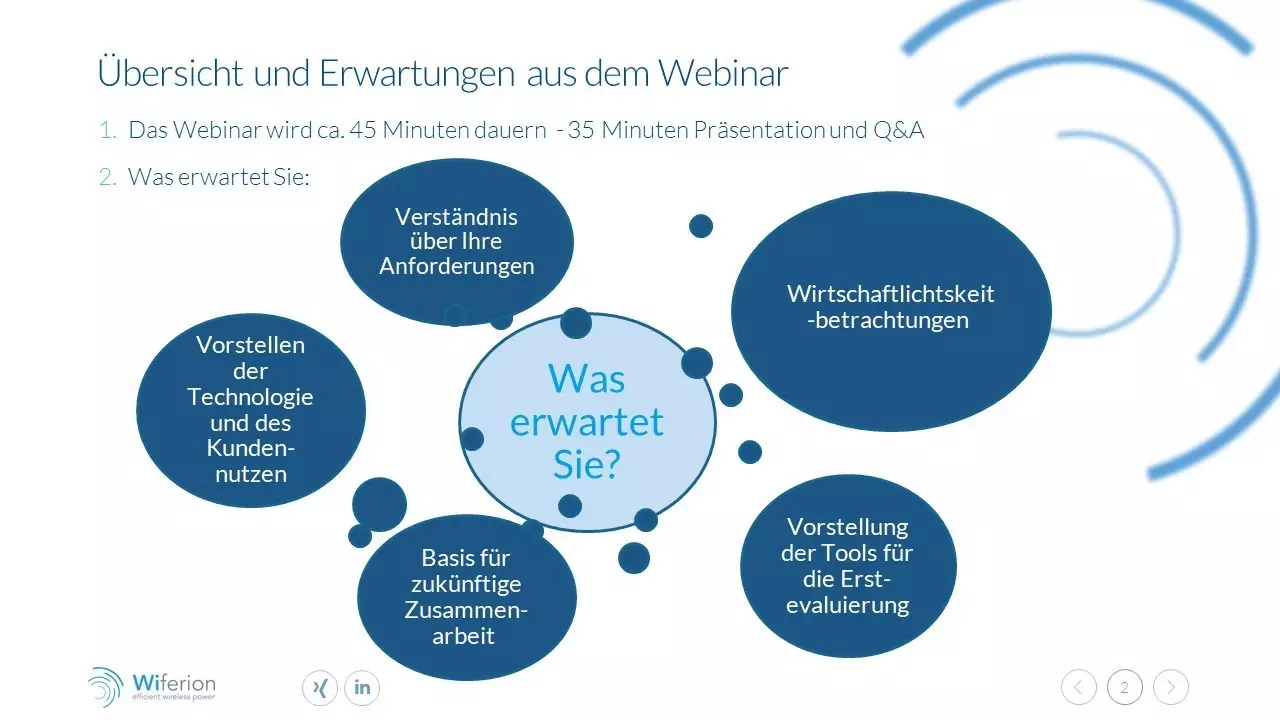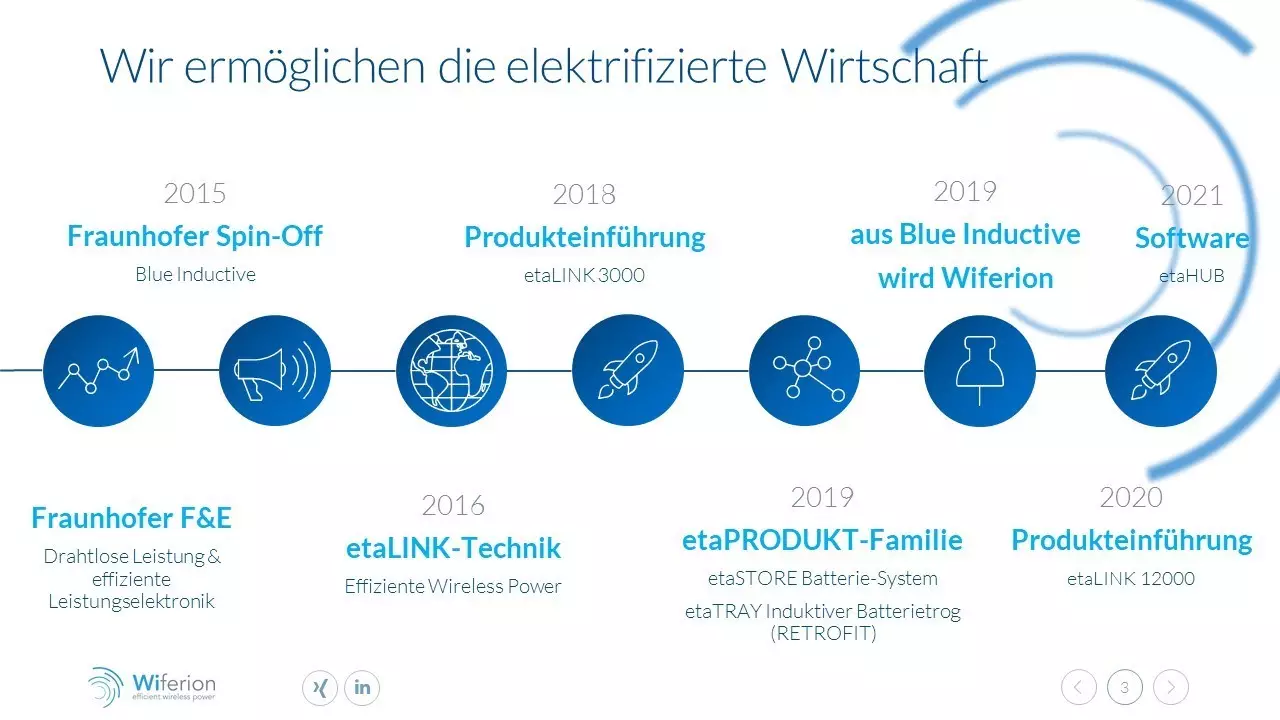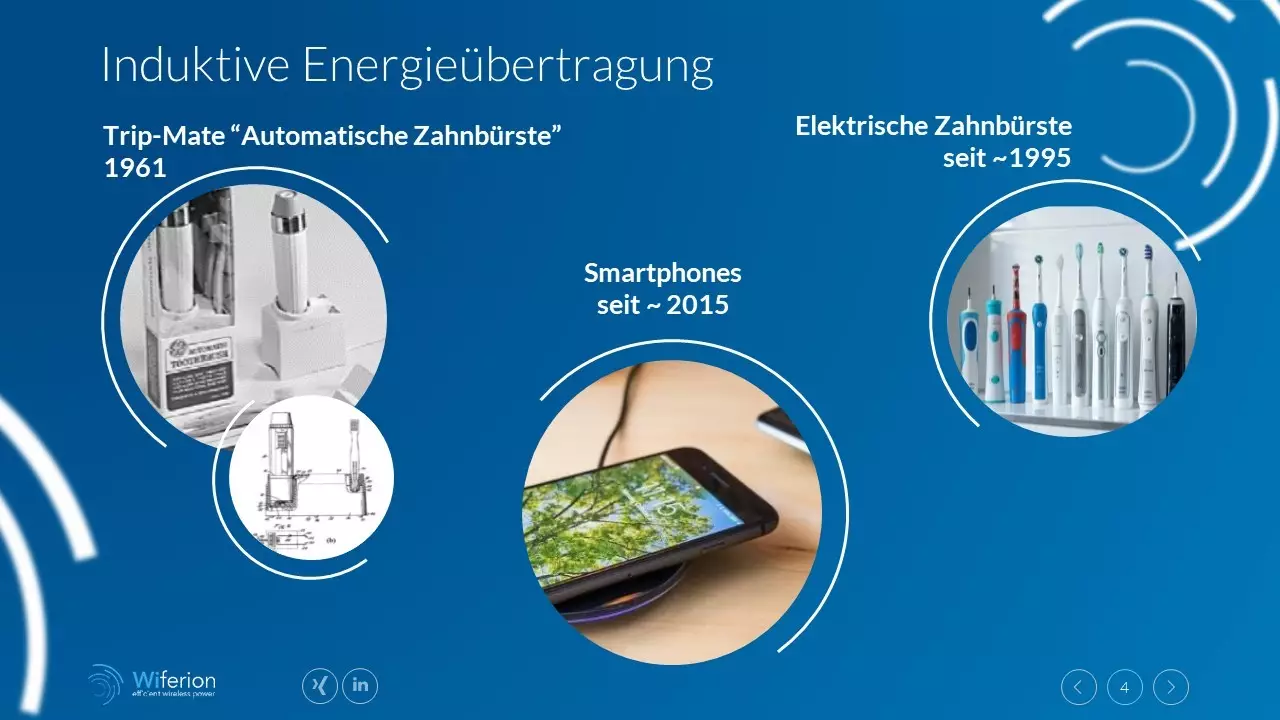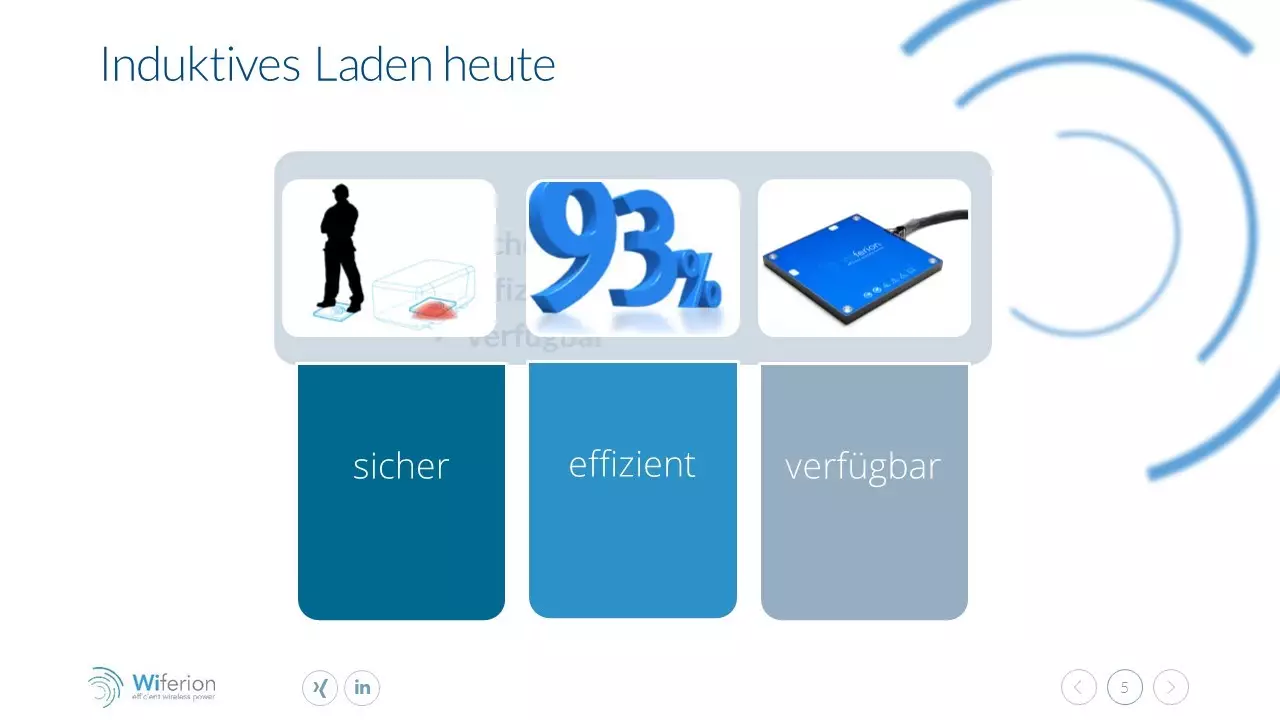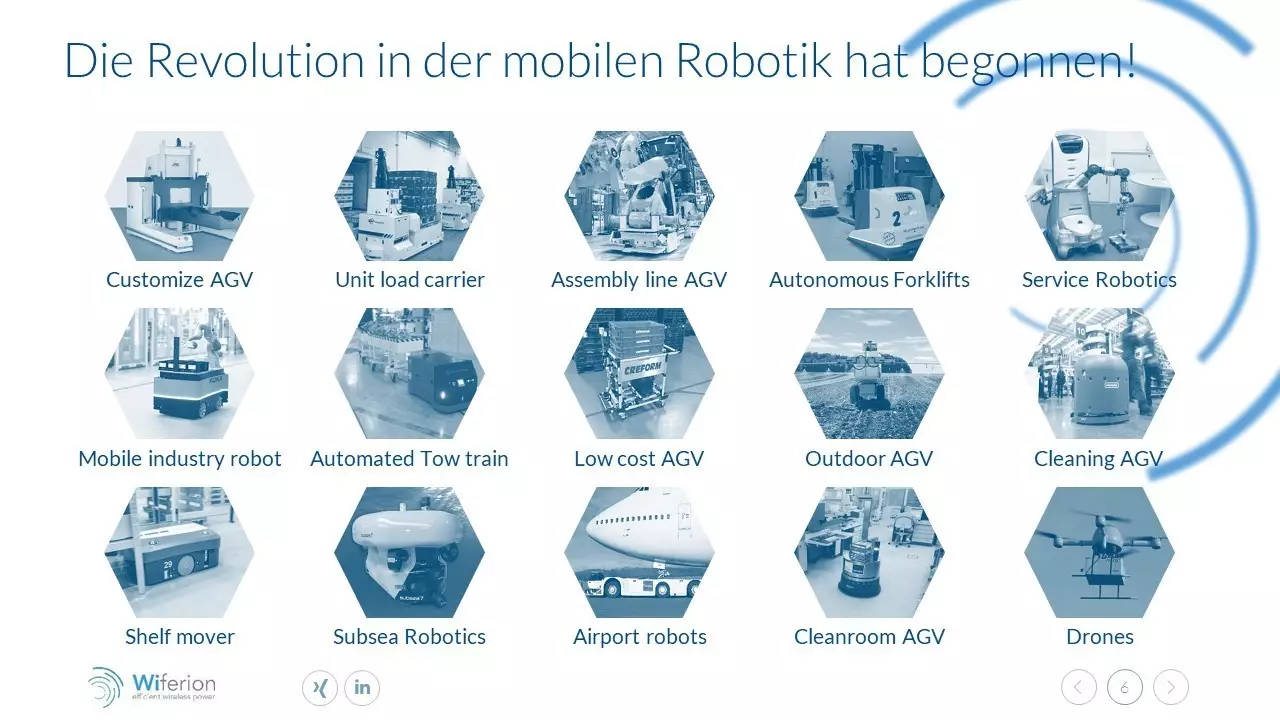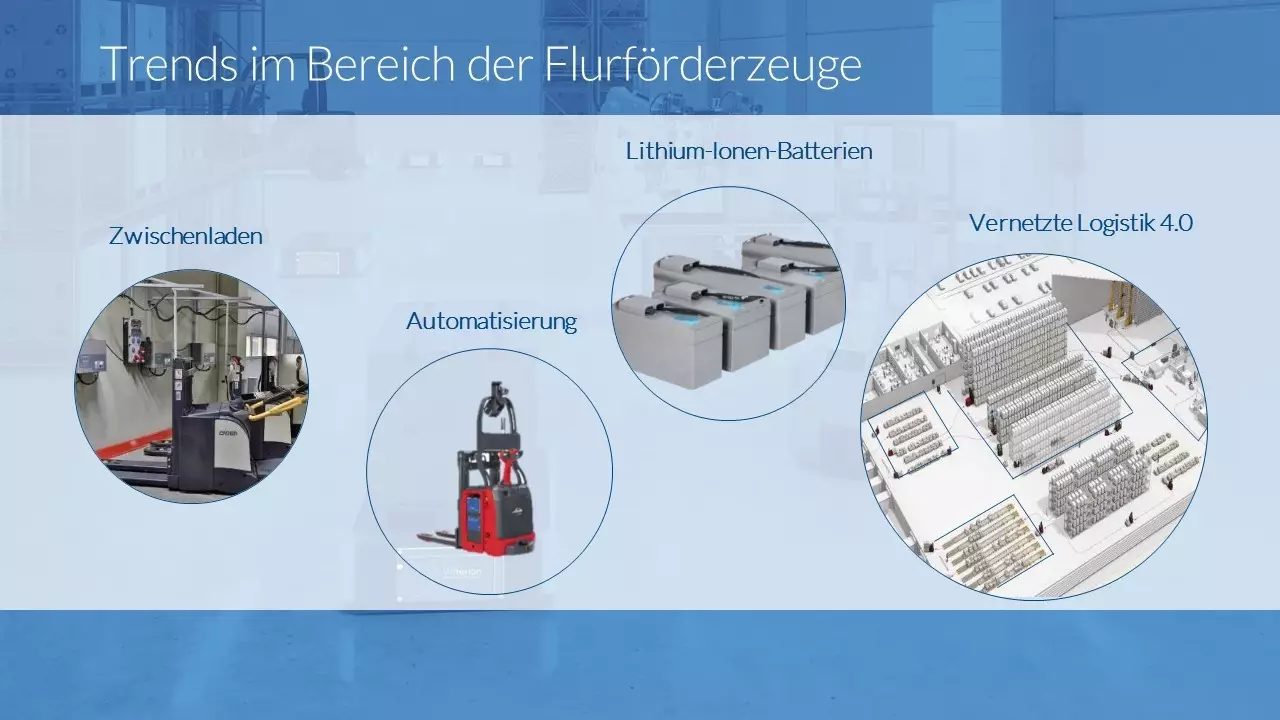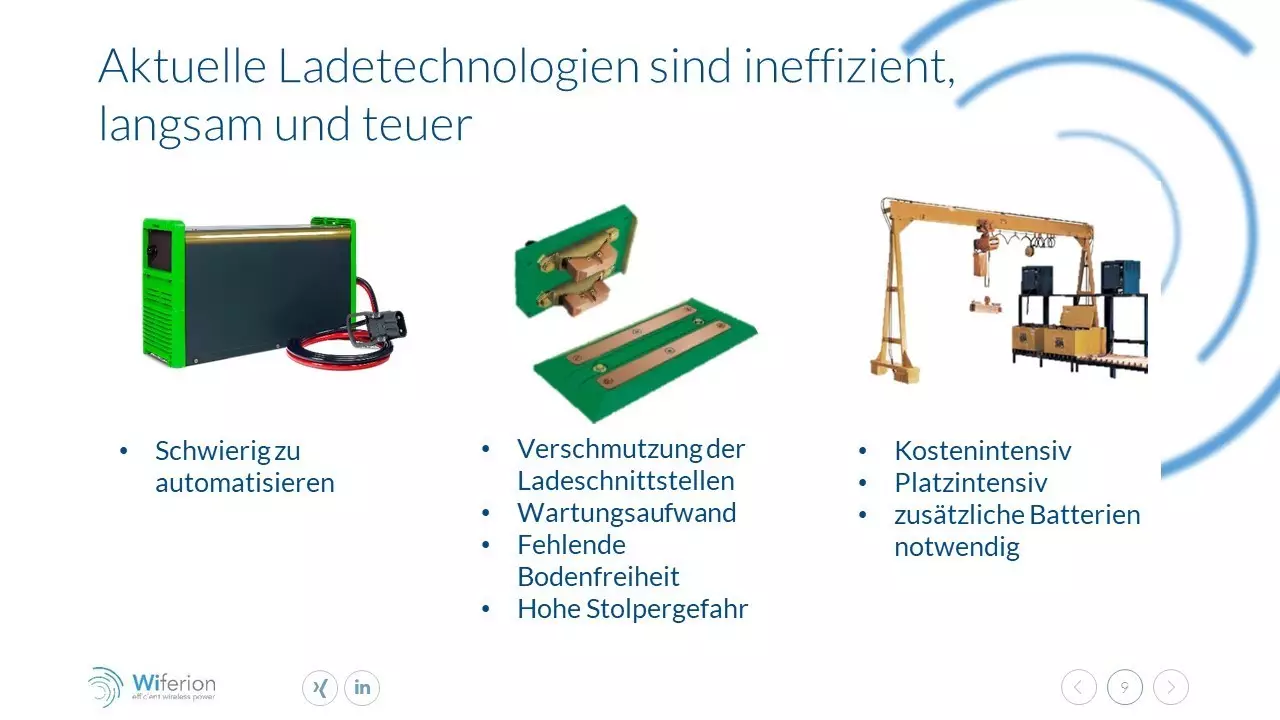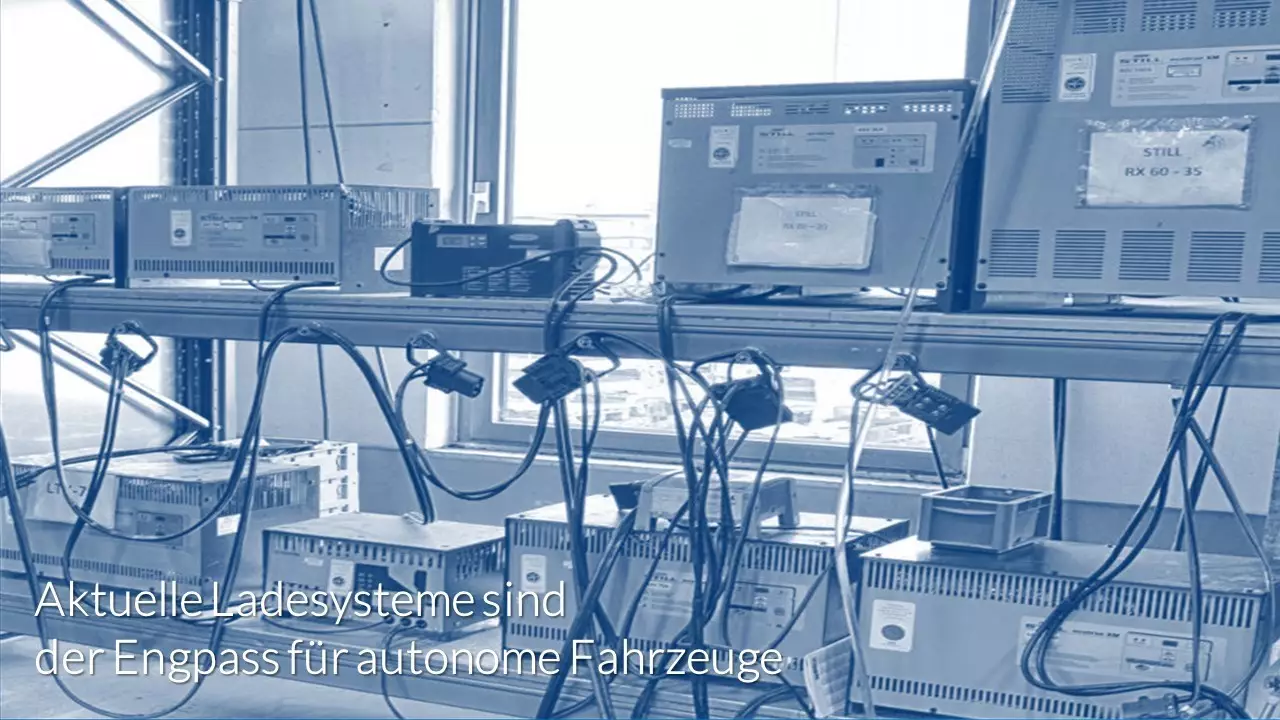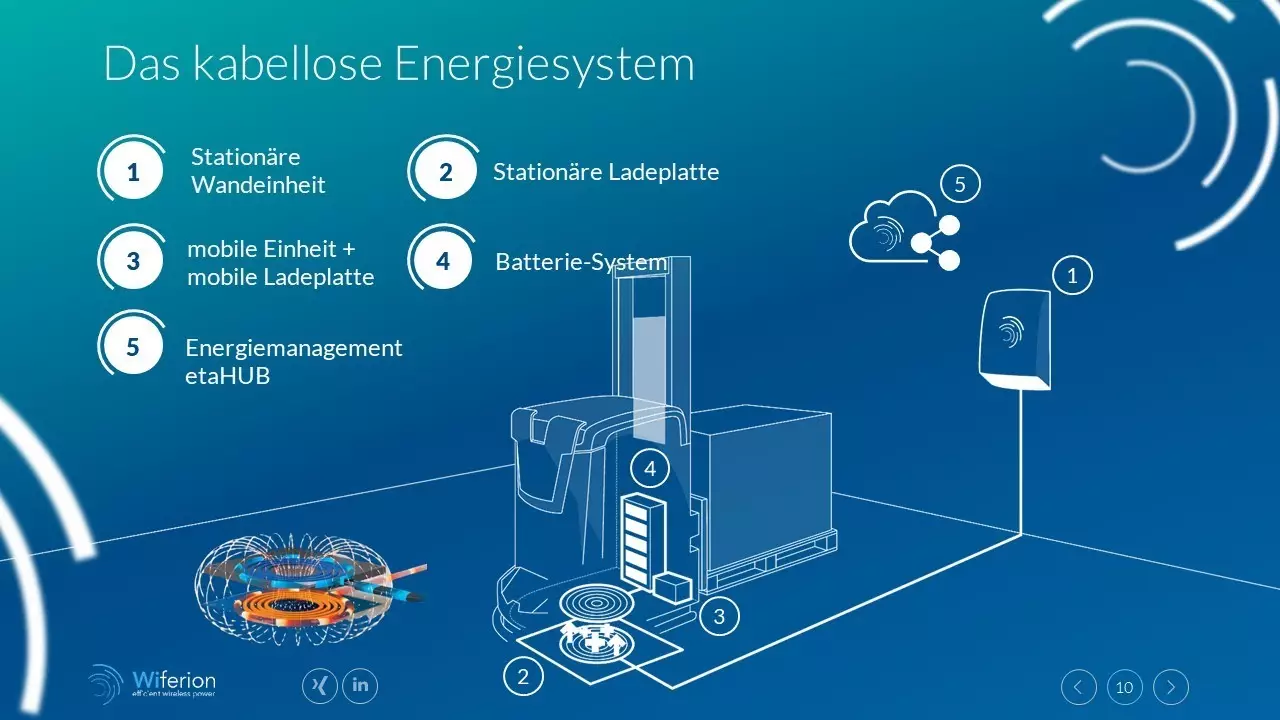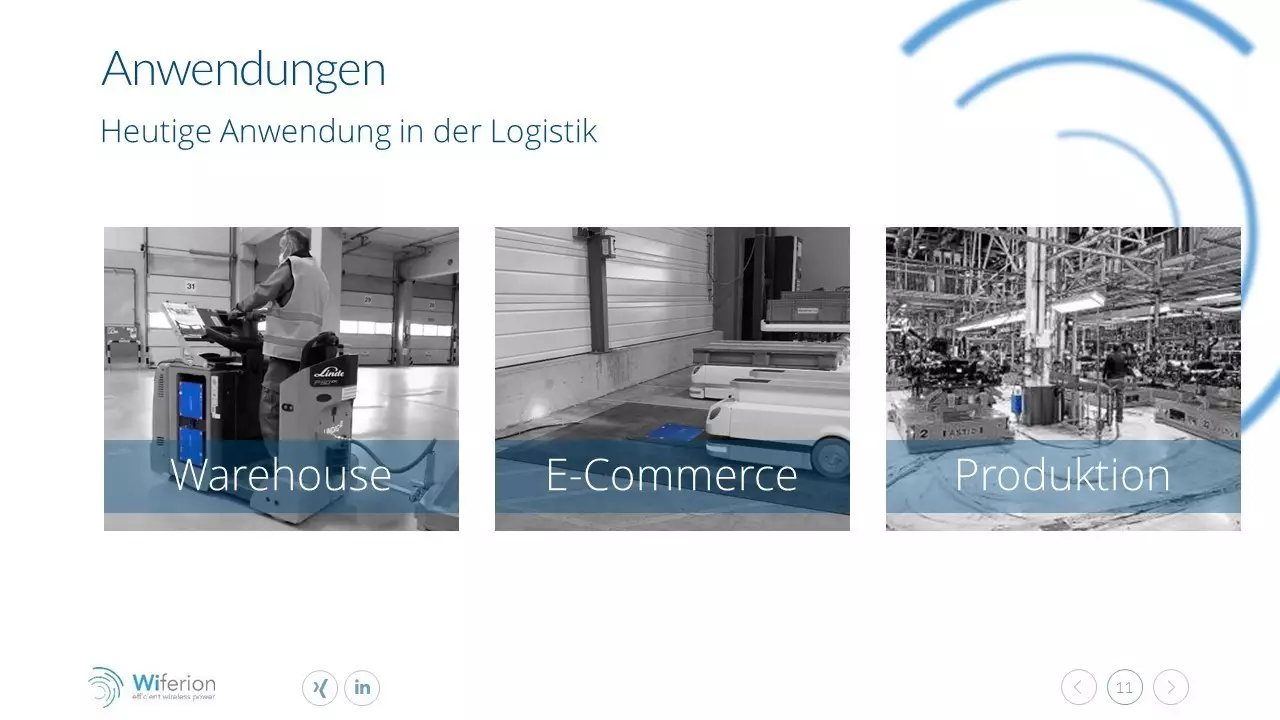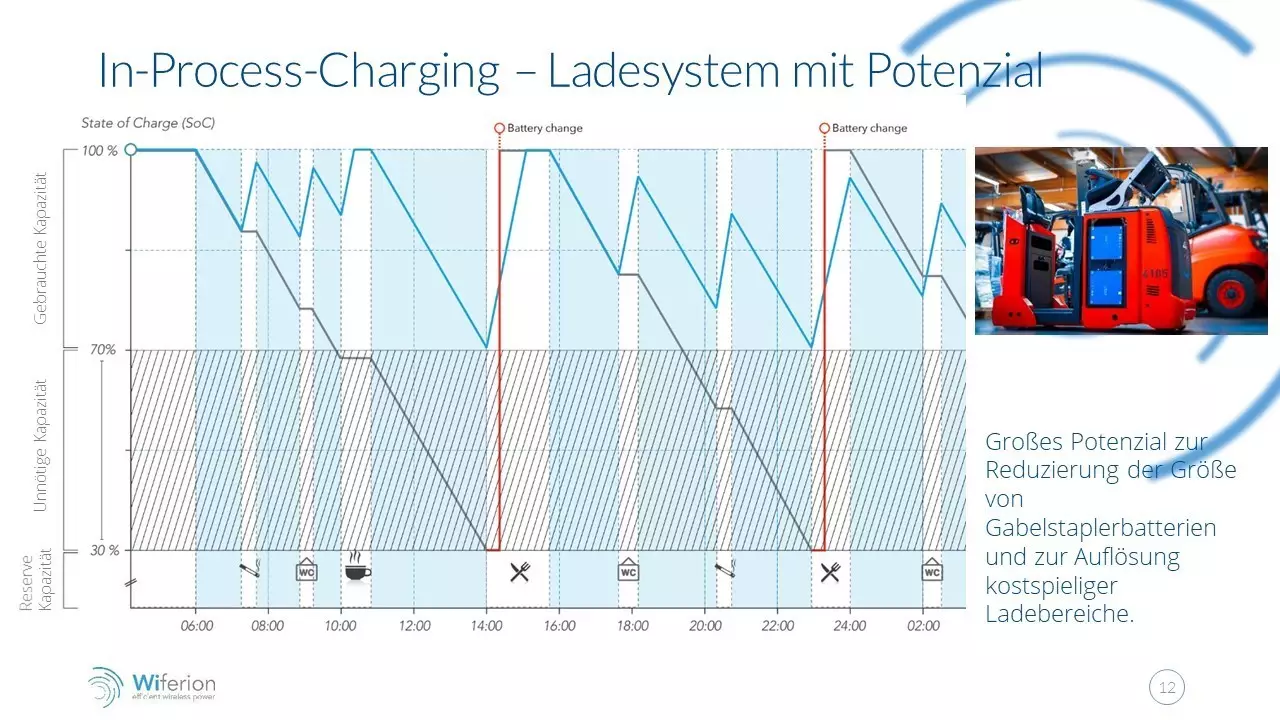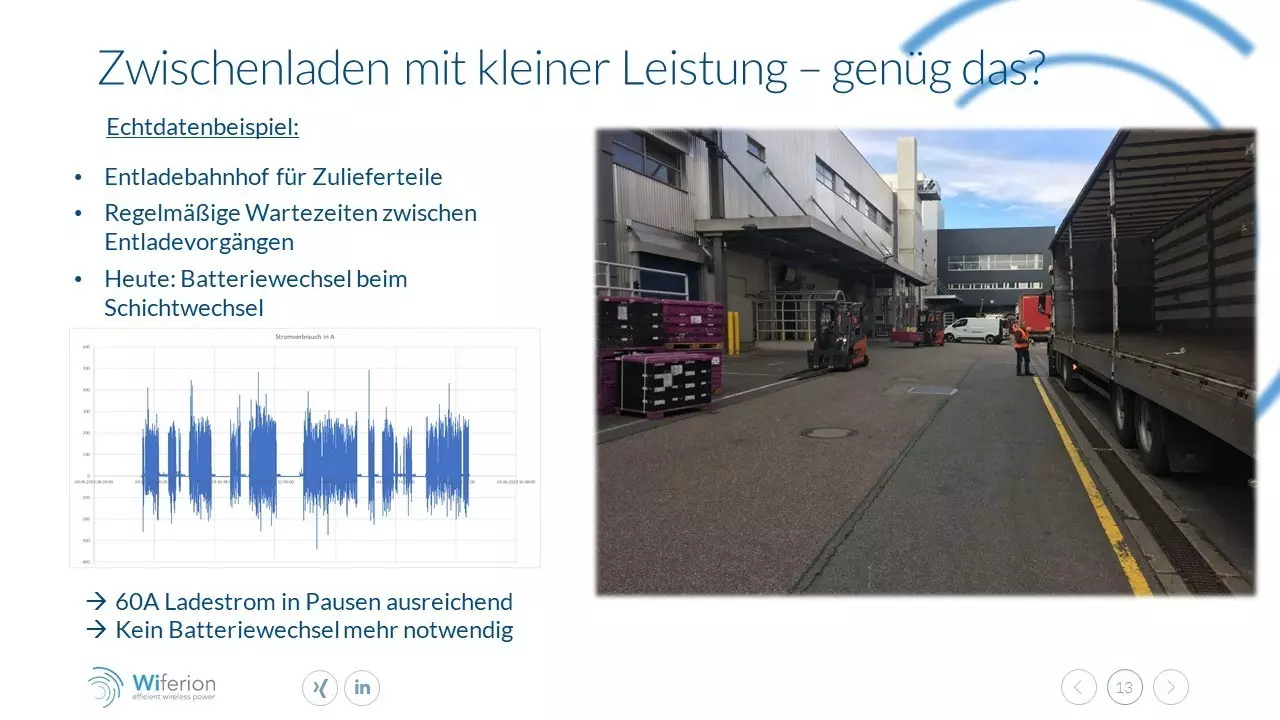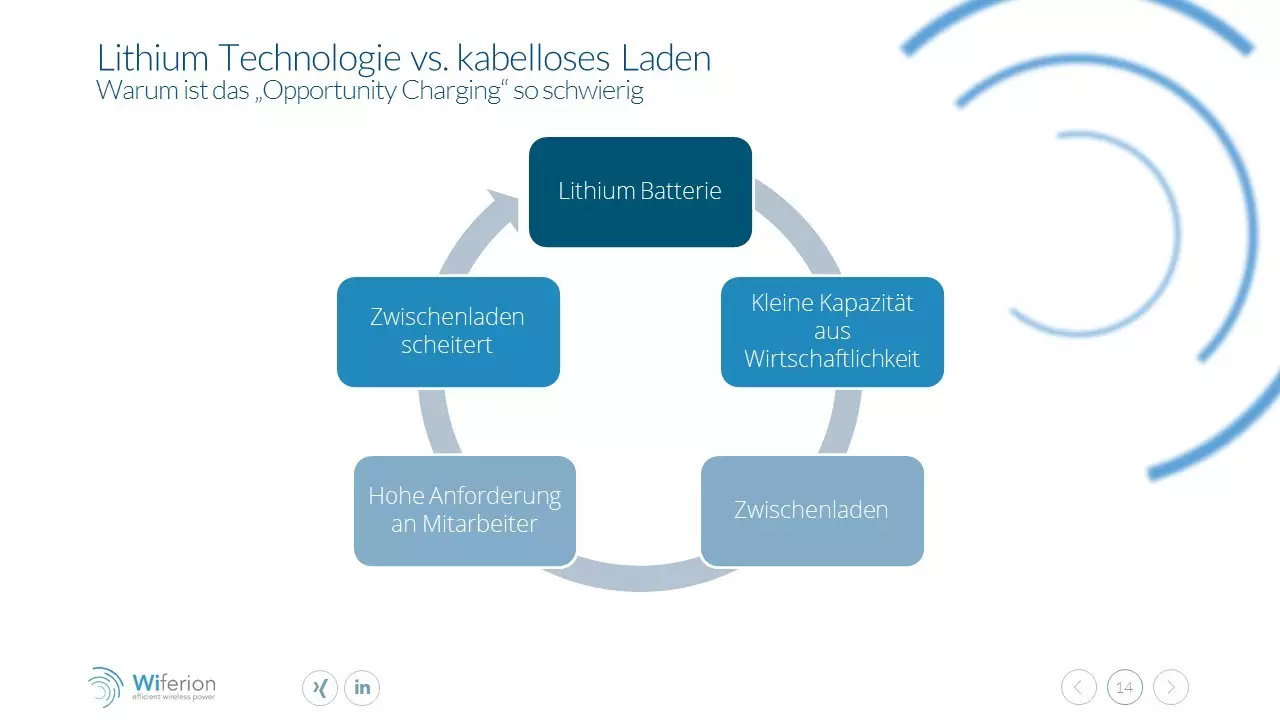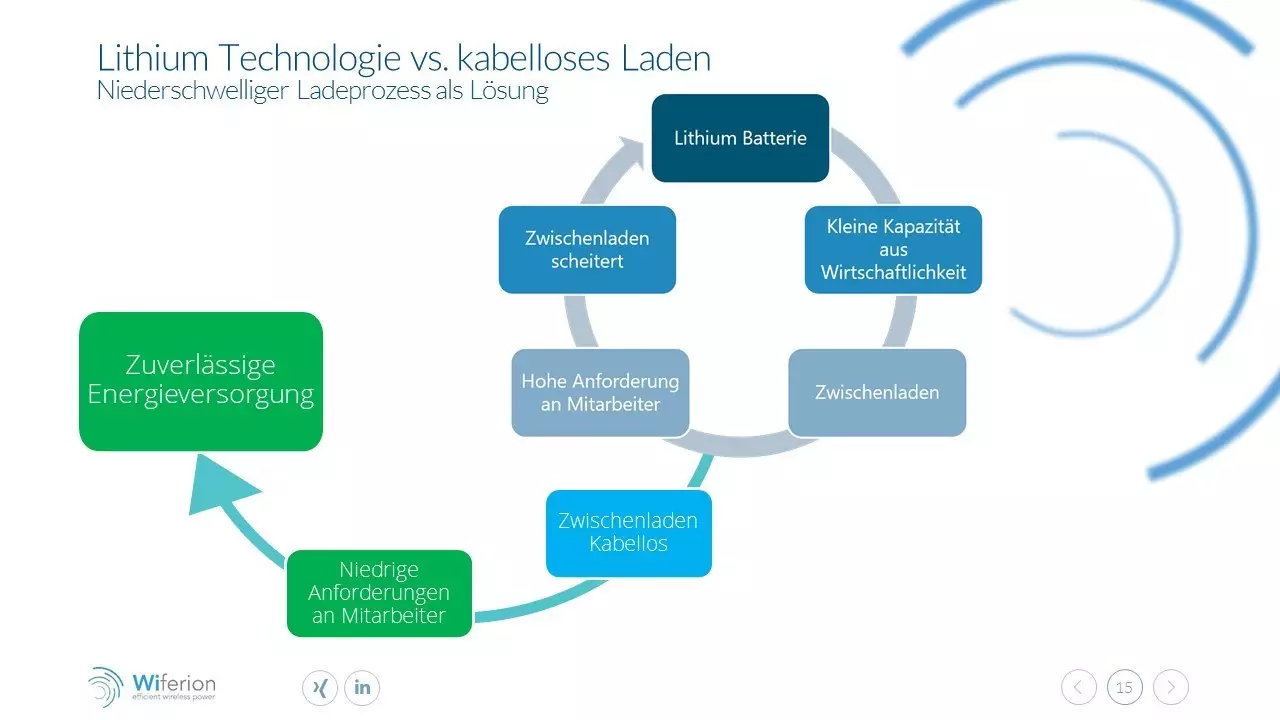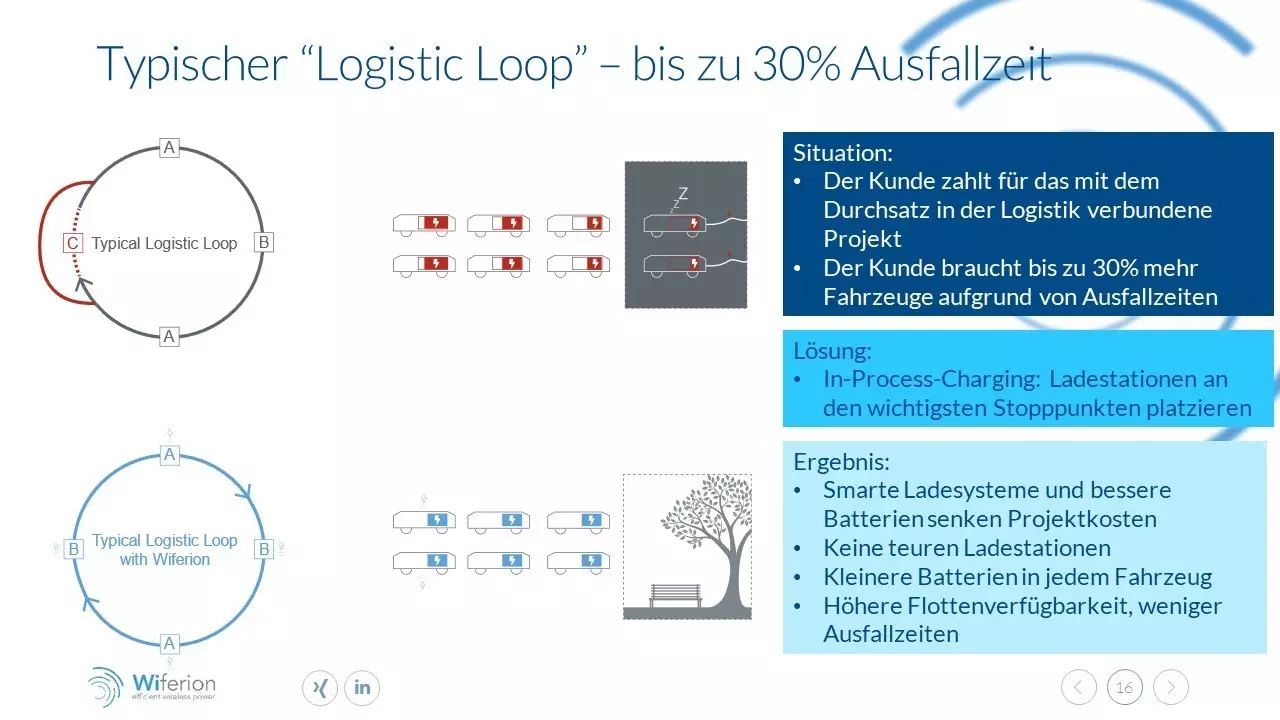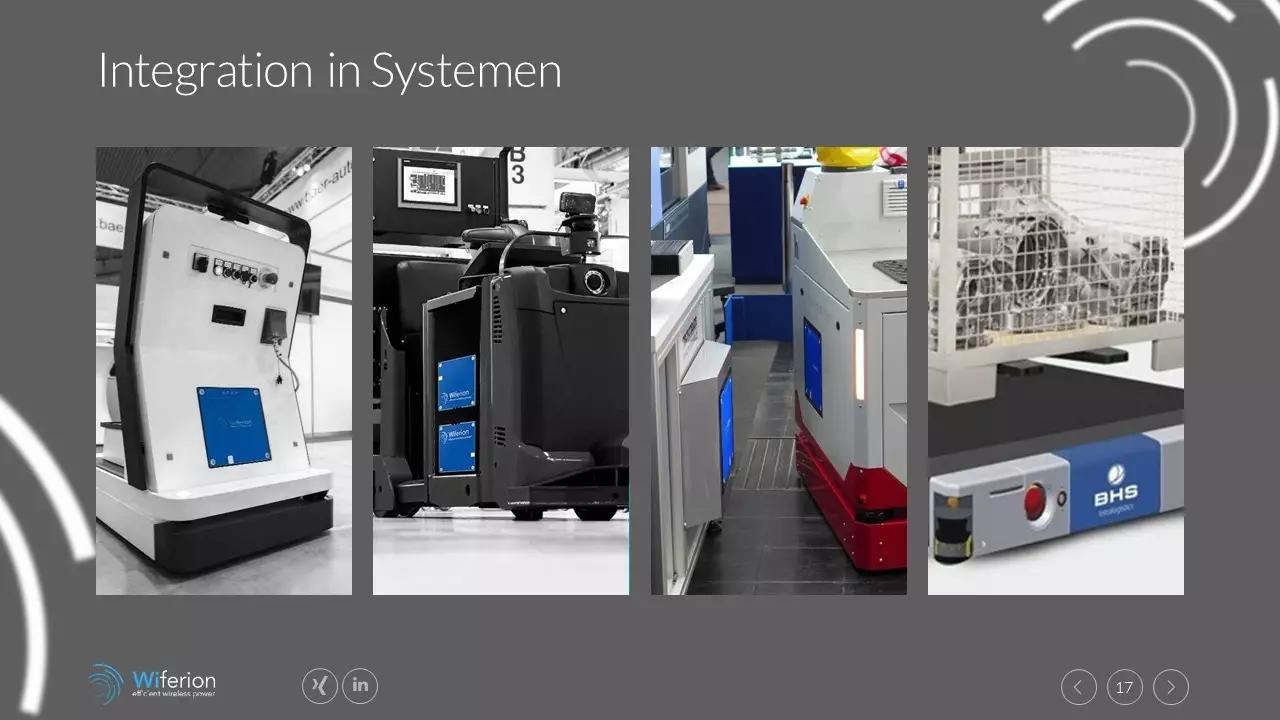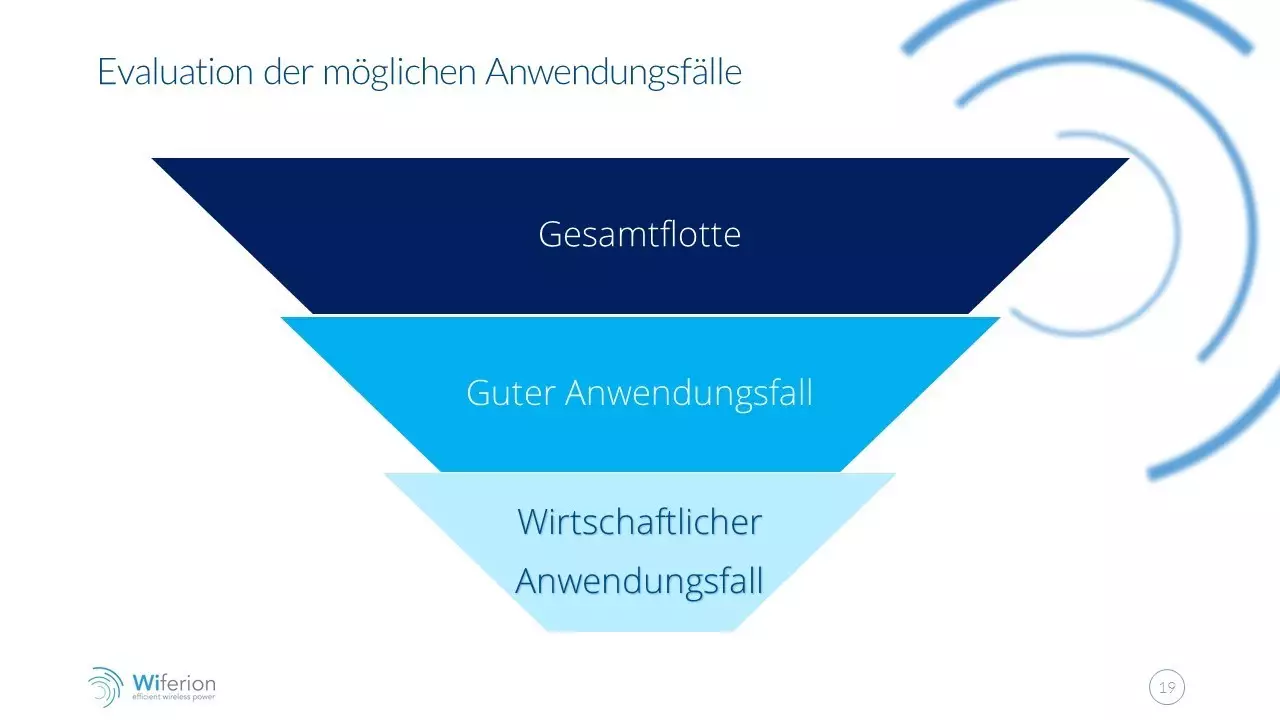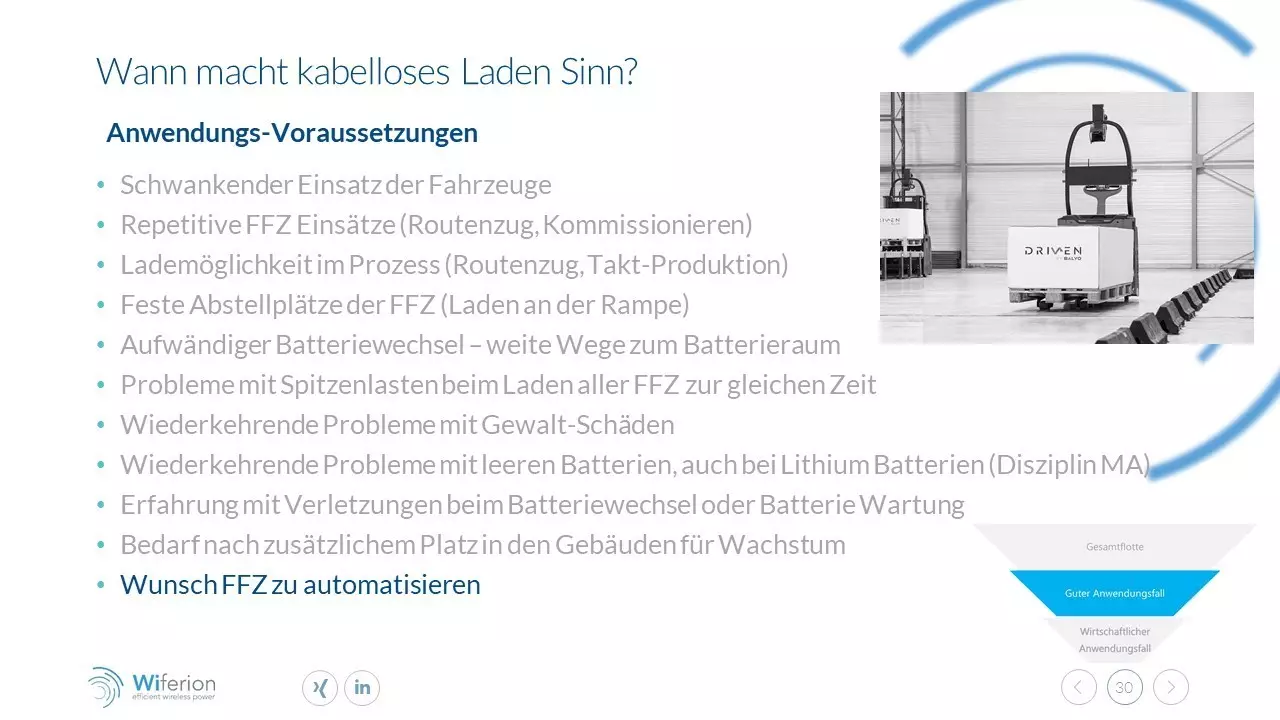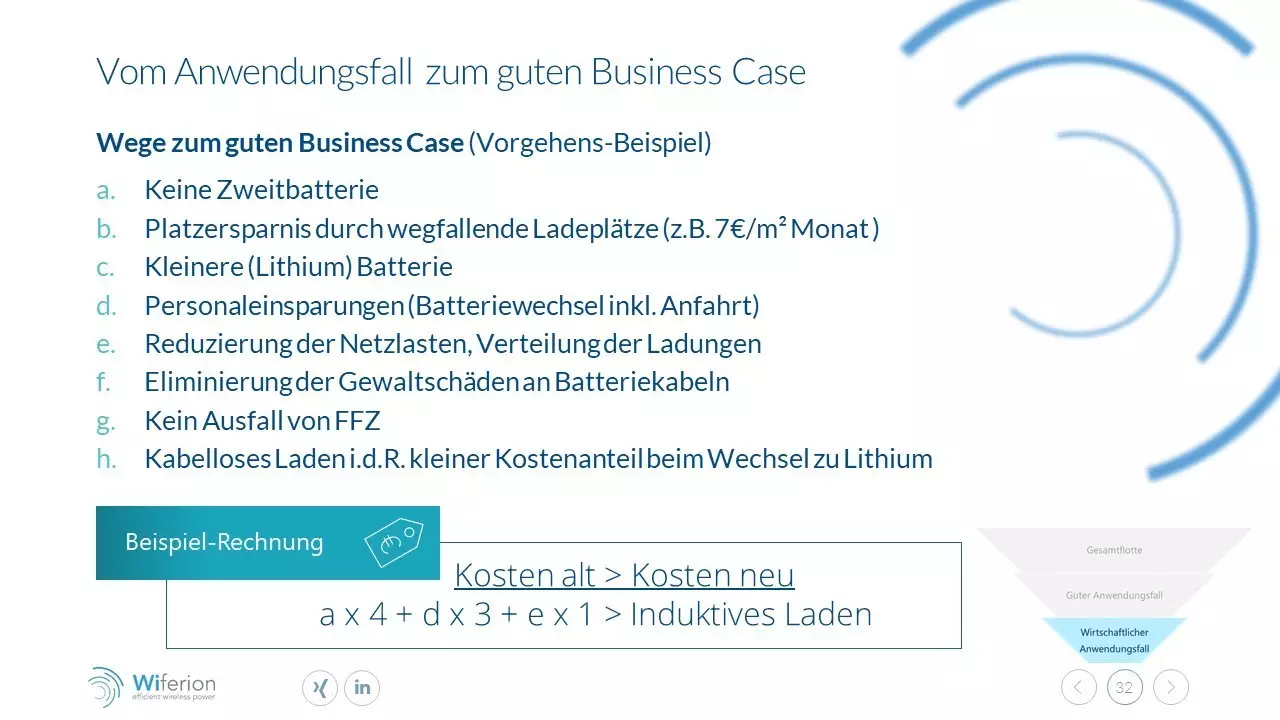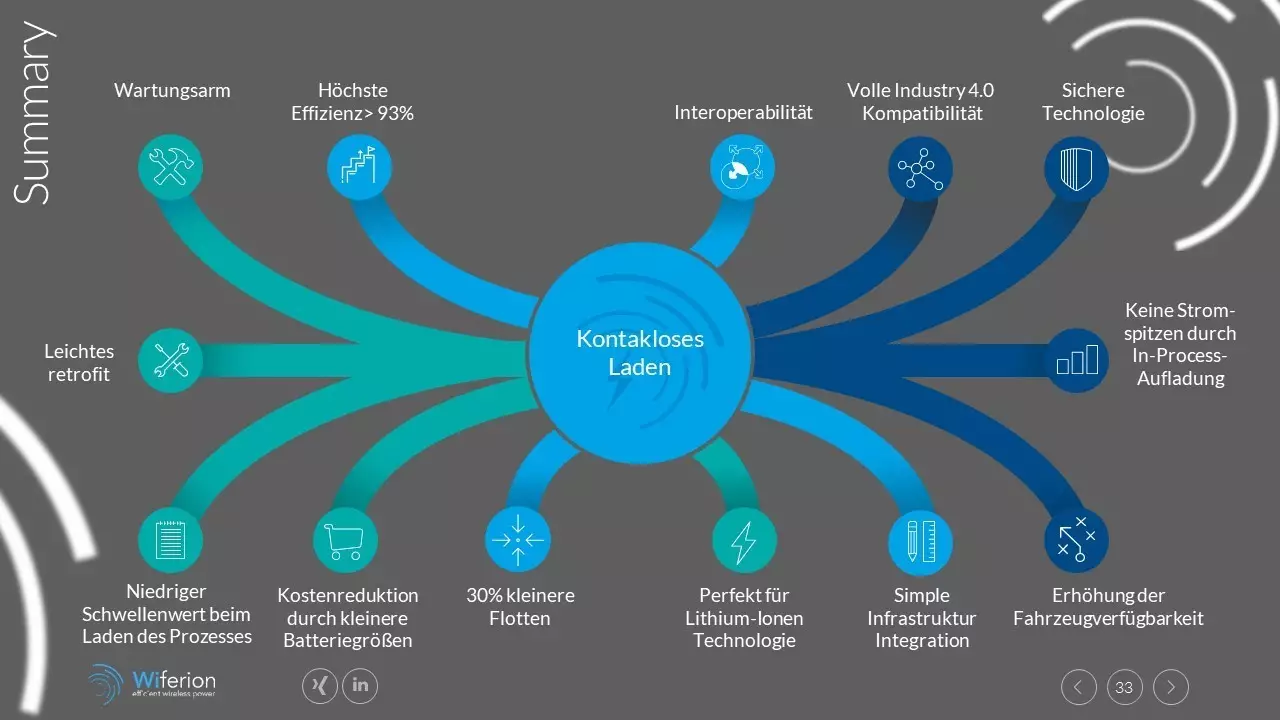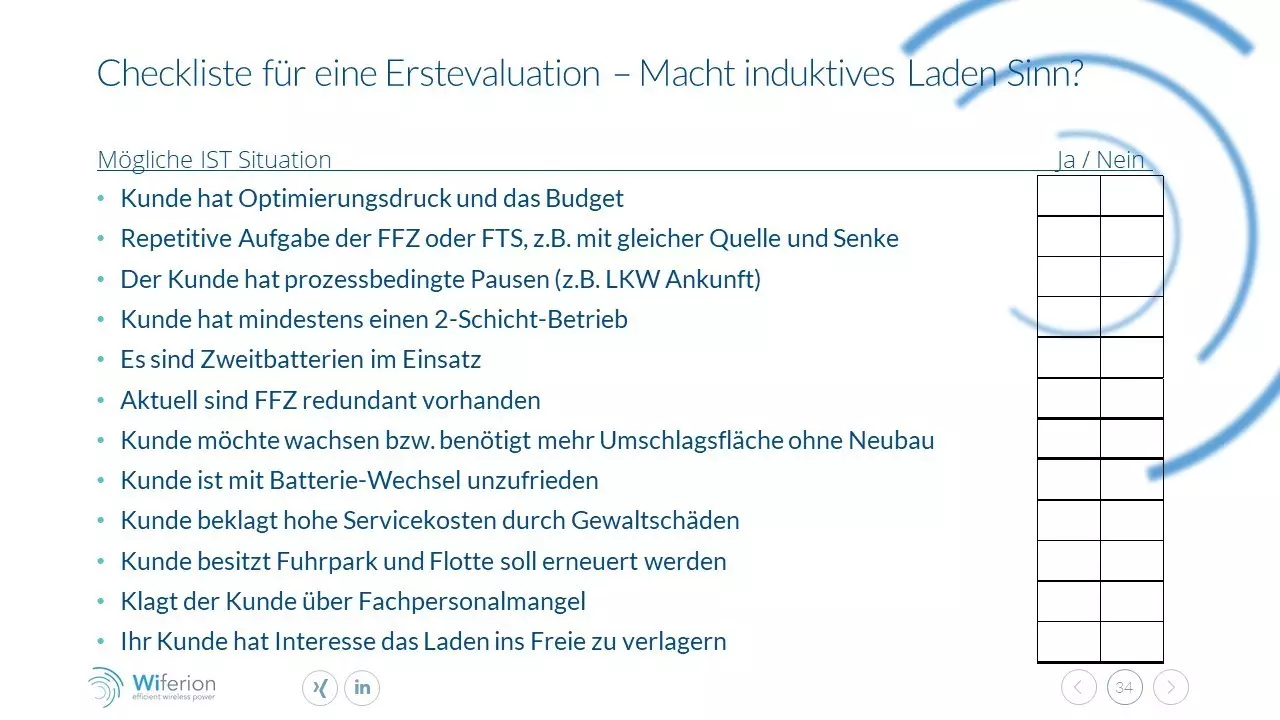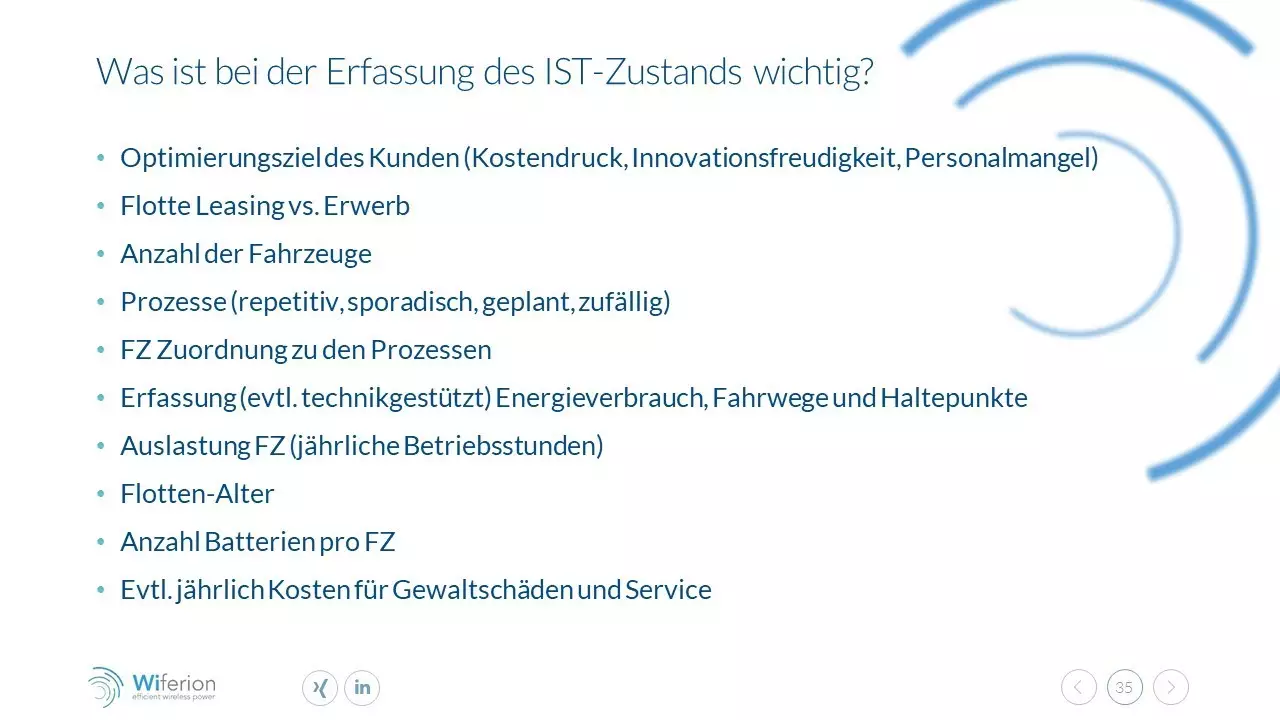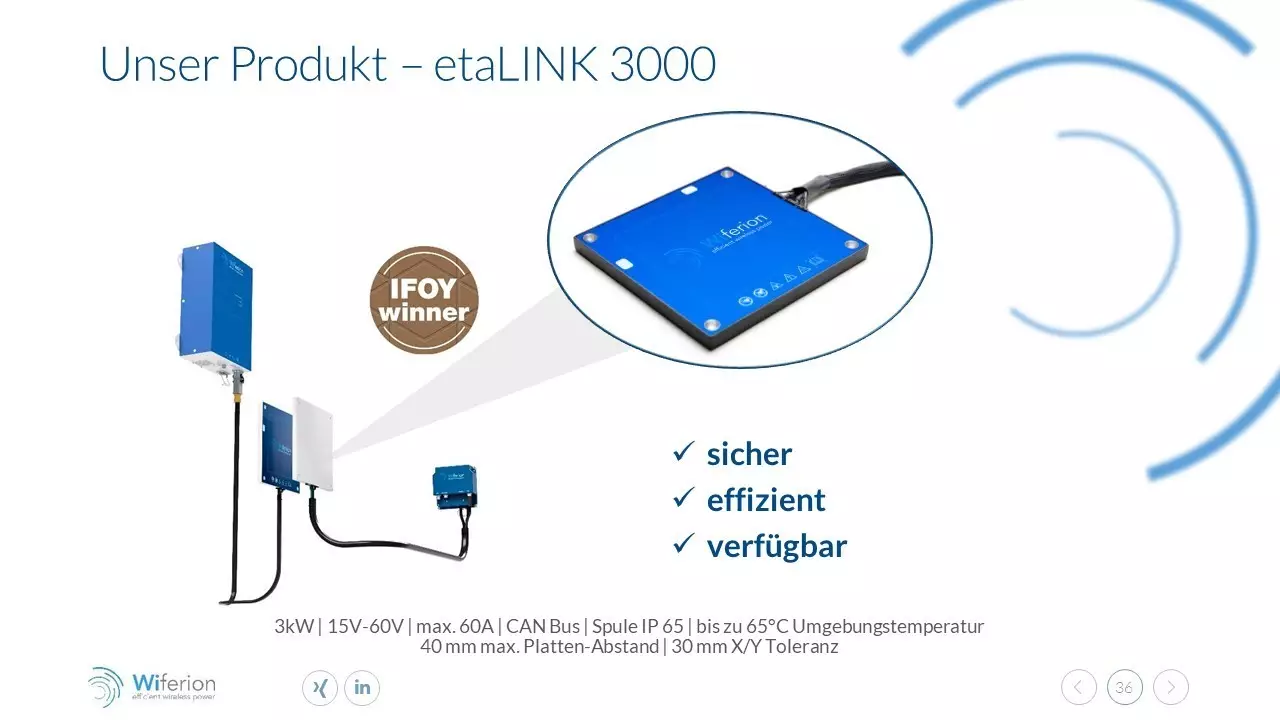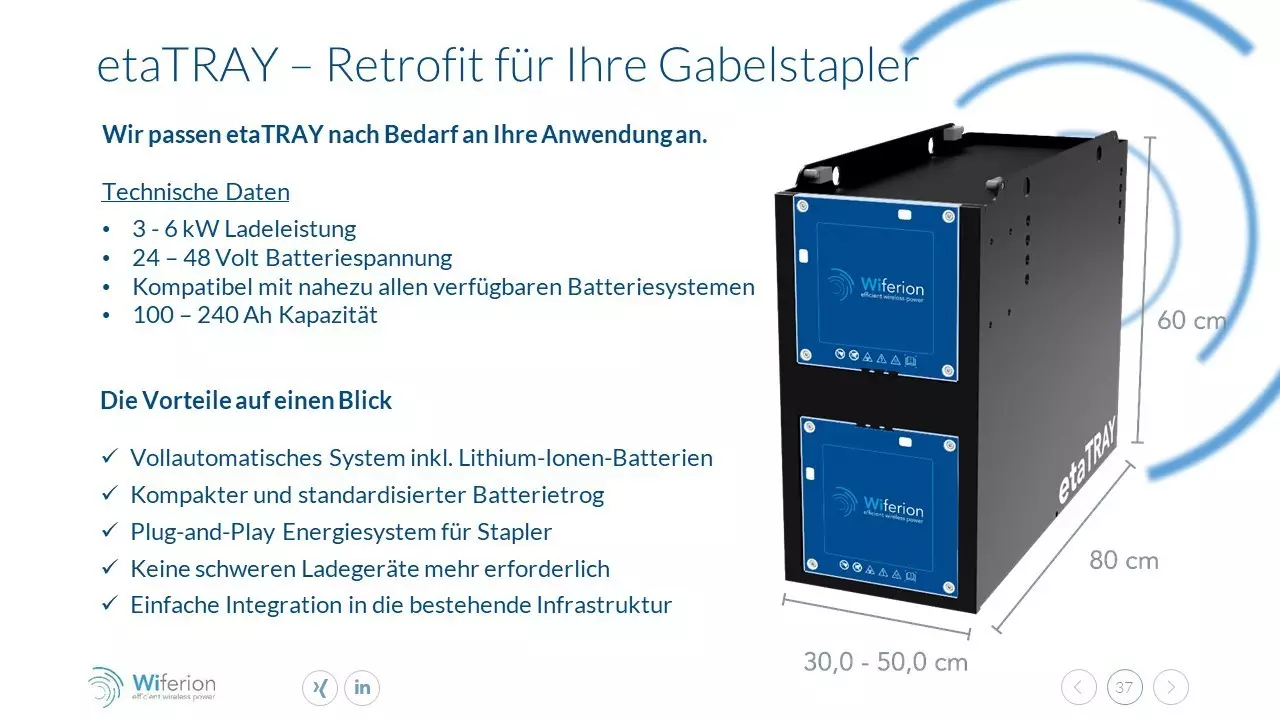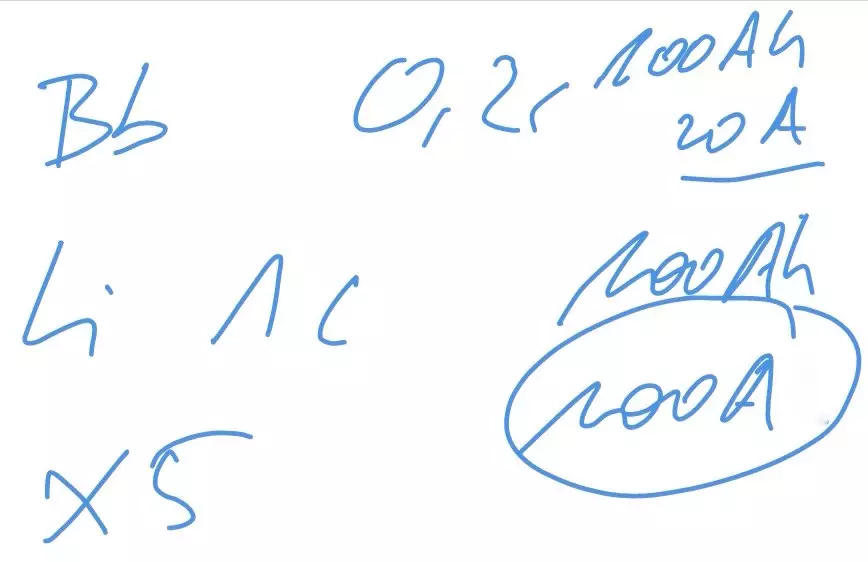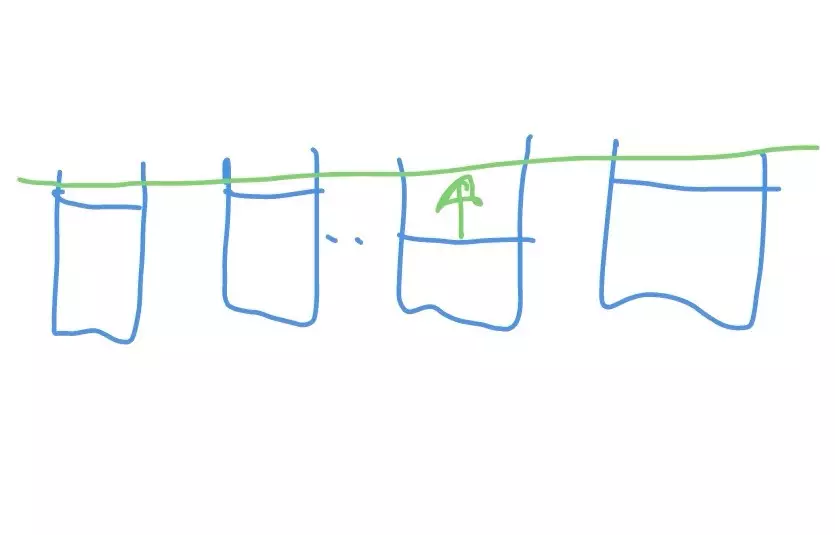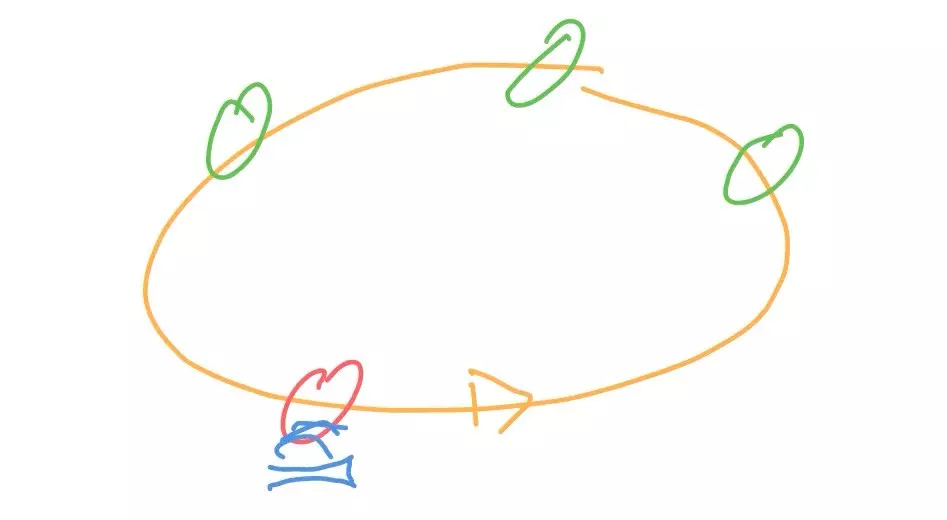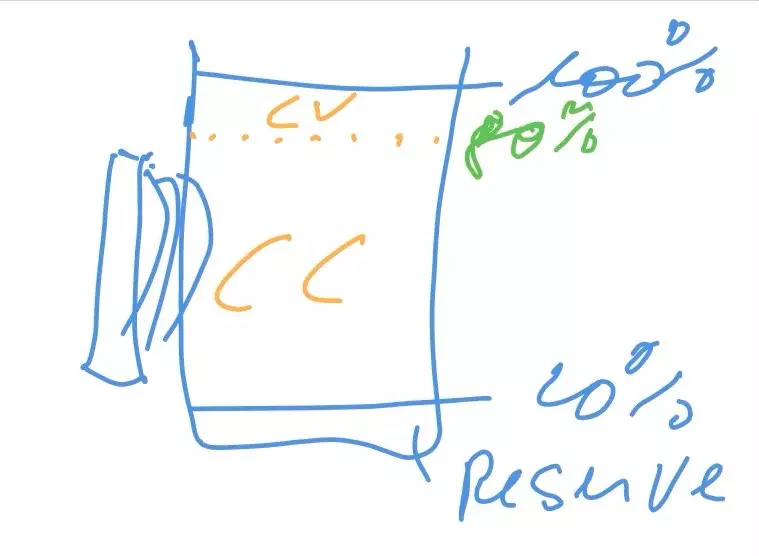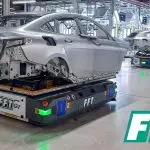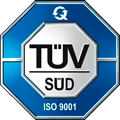Logistics Consultant Special – Inductive charging – Increase availability – Webinar
Die deutsche Version finden Sie hier
01.Oct.2020 – 2 p.m.
Increase vehicle availability in logistics
Transcript of the video
Julian: Welcome to Why Wireless Monthly Energy with the topic Consultants inductive charging for FFZ and AGVs. We have brought a little presentation here today, which I would like to start right away. And we are looking forward to discuss, explain and discuss with you the topic of inductive charging for more availability at your customers. Yes, how did you introduce us? Exactly: Questions in the chat in the lower right corner of your browser you have the possibility to formulate questions during the webinar. We will try to answer them together at the end. Very briefly Who are we? Who will spend the next three quarters of an hour with you today? My name is Julian Seume. I am the Chief Marketing Officer or Marketing Manager and am responsible for the organization and moderation, so to speak. And with me today is Matthieu.
Matthieu: Exactly:Matthieu Ebert I am responsible for sales at Wiferion. I have a background as an electrical engineer and am therefore also responsible for consulting on energy and energy design and I am pleased to be able to introduce you to our technology today. Perhaps one thing in advance It should be about the products. We take a conceptual approach. It’s about the technology itself and I think we should just start right away. What can we expect?
What can you expect?
Julian: What can we expect? What awaits them? It’s more about our ability to understand what your requirements are out in the field, in your logistics projects, at your customers. Of course we would like to present the project or inductive charging in general as a concept. Present the benefits & advantages and also the customer benefit. How could such a common cooperation look like? Is certainly the end. And very important: How can it be considered economically. Because availability, availability, availability I have learned. These are the three most important topics in the current logistics discussion. Well, maybe just a short introduction to who we are: Wiferion is a startup, which emerged in 2016 from the Fraunhofer Institute in the ISA in Freiburg, Germany, has been working and researching on inductive charging solutions. We have had an inductive charging system on the market since 2018, have added batteries in 2019, in this case lithium-ion batteries, in order to be able to act as a total energy supplier or energy system supplier, and continue to develop products such as wireless charging systems, software solutions, always with a focus on mobile robots, intralogistics and mobile electronics.
Julian: I would start with a clear statement inductive energy transfer.
Each of them probably has it at home in the form of an electric toothbrush or cell phone. And also clear statement. We did not invent it. I think Nikola Tesla was so smart a few hundred, twenty, thirty, forty years ago and developed the concept. Among other things, we used it for our product development and it’s exciting to actually see it now. What is the current status of inductive charging solution today? And with that I would like to give you the most important three questions.
Matthieu: Please. Thanks a lot. We have thought about the fact that we would like to start by simply clearing up the three most common prejudices that we are repeatedly confronted with or the technology itself. Our technology is not safe, it is inefficient and it is not available. And I don’t want to relate this to our products so much as to this inductive energy transfer in general. Today we can say with a good degree of certainty
- Our implemented solution is safe! We meet all relevant standards. Our technology is very efficient.
- We have 93 percent efficiency. This is absolutely competitive with high-end European cable-bound chargers and chargers with…
- …our technology is actually available. So we are able to deliver. We are in mass production on the whole.
It’s no longer hocus-pocus. It is reality.
Automated processes increase availability
Julian: So let’s take a look, why is it so exciting now to bring an inductive charging system into logistics?
Matthieu: Exactly. So what’s important to us in such talks or webinars is that we look at the context a little bit and address it again. This slide shows a variety of applications from various industrial sectors where processes are ultimately automated, usually with mobile robots. And whether it is airports, in production, logistics, agriculture. We see that we are in the middle of transformation and all kinds of processes are being automated. And there is one thing we can see very well here. All these devices or robots are electrically powered and it inevitably leads us ultimately to the question Where does all the energy come from? And that brings us to the charging technology. And now to focus not on agriculture, but on intralogistics and production logistics, we want to. I would like to share with you what trends we are observing, what we are being asked about, what we are analyzing. And especially now, in the corridor in front of the witness, these three trends are very important to us. Four trends, together with the one about networking, have thus become apparent. First, the switch to lithium-ion batteries. So this is the desire, the path to a robust energy supply. Vehicles are to be automated step by step. And with lithium-ion batteries, intermediate charging is actually inevitable. And we will see in a moment how all these trends can be very well supported by inductive charging, fueled by wireless charging technology, industry.
Current charging technologies are inefficient, slow and expensive
We brought something with us once. That’s one of the things that looks like a yes, it’s a medium-sized company. I think that 12 different chargers. I made another foil. What are the typical current traditional charging possibilities or technologies that are present on the market?
Matthieu: Exactly here again very important to understand where we can go, where we want to go. I think it is important to understand where we are at the moment, where we come from. And on the slide you can see the three common charging technologies that are very widespread on the market today. On the far left is the cable-bound charger, which everyone of you knows. On the far right the battery crane symbolizing battery change in the industrial truck business. Probably over 90-95% still realized and in the middle, the charging contacts for the automated solutions for automated driverless transport systems or industrial trucks and all these charging technologies have their legitimacy, do their job more or less well, but are all limited in a certain way! Concerning your P.M., your potential for automation and the reasons for this need not be so detailed now. But this is the state of the art. That’s where we start from and now you can see where we could go. And in order not to understand this from a technical point of view, but to approach it conceptually, we would like to share our vision here.
We have to imagine it like this: Loading the corridor in front of the witness or the AGV is actually not a value-adding process, so if you buy yourself a forklift today, you are not buying it because it is hanging somewhere on the cable, but because it ultimately handles goods. With an AGV it is exactly the same in production. We want assembly to take place on the AGV and not on the loading bay. This means that we also have a non-value-adding part in our overall process. That is the energy supply. Our vision, which we are also symbolically presenting here, is that the energy supply can be completely integrated into the value-adding processes in order to optimize the added value, and in principle the availability, of the vehicles. And in the very specific example we are showing here, it is indicated in forklift trucks or a front loader has to stop somewhere to pick up a pallet anyway. In this example, this would be a neuralgic point / strategically sensible point, where we could realize a short stopover with our charging technology.
The inductive energy system
Julian: Well, the goal is exactly the same, first take a quick look at which elements are there, because some people may not know the system or how it was built. We are one, two, three, four, five points also called. It is relatively simple. There is a wallbox. Once you plug into your power supply in the hall or your production plant. Then there is the mobile unit that it can be seen in the area of two. There it is nothing mobile, but the stationary unit. That means there you have the wireless charging pad on the floor integrated on the side. We will show you two or three more installation options in a moment. Then there is one against charging solution, i.e. a counter-coil, so to speak, on the vehicle, which then communicates with each other when the two coils meet. And of course there is a mobile electronic unit and the battery. In the long term, this also suggests a digital or cloud solution for extracting data from the charge and using it. Let’s take a look at where the whole thing is used. Matthieu I think you also had some good examples where it makes sense.
Today’s applications in logistics
Matthieu: The same focus, which today stands for our approach is ultimately intralogistics, warehousing, e-commerce, i.e. good-to-person, person-to-goods, picking and shelf moving and production logistics. And we are focusing on these three applications because we believe that this is where the rollout can take place most efficiently and fastest. We do not focus on automotive applications, so our system is not available for passenger cars. These are our three applications and I think that the audience today is also moving in this area of application. Still at the very front is a Tugger Train in the warehouse.
Julian: Maybe we’ll have a look at the use case you brought along.
In-process charging – charging system with potential – increase availability
Matthieu: Exactly. So the question that comes up immediately when you want to introduce or introduce a new technology is actually
What does it bring you? What are the benefits?
And we would also like to focus very strongly on I would say customer benefit. And here is the very first example in the form of an exemplary diagram. We have shown the state of charge, i.e. the capacity curve from the battery over time and in three shifts. And the gray line would now be the typical battery state of charge over time. So in the morning you start with a full battery and at lunch break two the battery is empty and needs to be changed. It is the red bar. But if we now have the possibility to charge the battery with a low-threshold I say well integrated charging solution like inductive charging, then we get to this blue line. We manage to keep on charging during the day, during the shift. And what we see here is actually one of the first pillars of the good economy factor: we ultimately manage to reduce the battery’s capacity. If we assume that we need or use 100 percent battery When changing the battery, we can save 30 to 40 percent battery capacity by charging between charges, and 30 to 40 percent battery capacity is in fact directly in euros and this is the first pillar that we can use when calculating the cost-effectiveness of the systems.
Availability with small loads
Julian: Well, that’s a theory and or exemplary example. I know, you have measured the whole thing live once. Maybe it will give you an impression so that the listeners understand how it really happens in reality and what you can do.
Matthieu: Right. We are with our charger. If we are in the 60 ampere charging league, I would say 60 at the tarpaulin charging current and for many industrial trucks it appears at first glance as little current. Yes. But that is actually said, not necessarily the relevant size, but the question is: How does the charging current match the demand? How does the charging current match the power consumption of the vehicle and what we actually like to do. We accompany our partners, our customers, from the initial recording to the finished solution. And here you can see how we unload pallets from trucks at an unloading station. At the front forklift we have calculated the power consumption overtime. In the end we log the power consumption. This is the blue time series and now we are able to analyze how much charging current we need if we would use all breaks longer than 5 minutes for intermediate charging. In this particular example, we found out that with 60 amps charging current we can cover the whole energy demand of the truck, if the truck is positioned, parked and reloaded at a charging station every break longer than 5 minutes. I think we can assume that the truck would not have done this if it had to plug in a cable during this time. And for us it is very good proof that low-threshold charging is actually the enabler to institutionalize intermediate charging.
Lithium technology versus wireless charging
Julian: Well, now we have just looked at an example of the hall or the tugger train. Maybe there are other alternatives – not only is the charging solution available inductively for FFZs or as tugger trains, but also in applications such as AGVs or mobile robots.
Typical “Logistic Loop” – up to 30% downtime
Matthieu: Does not matter. The important thing is, how is the power supply organized today? And above we see a typical logistics Loop with four stations. And we also see this red path. That’s the offline one. Charging trip. This means that the vehicles are taken out of the system in addition to their normal process. If then such a charging station is brought and its vehicles, which are not value-adding at that moment, its unnecessary vehicles. Yes, if we now consider how we can optimize this, if we manage to integrate the charging technology into the processes, this offline charging process is eliminated and we save these additional vehicles that were necessary to get on the net fleet. That is the second important pillar for good profitability, they can do it with in-process charging. With the systematic in-process charging we manage to make the fleet smaller. And if we consider that an AGV costs between 10.000 and 50.000 euros, for example, we can roughly say that the energy supply for the entire fleet is actually financed from the first AGV that is saved. And in our opinion that is a very good pitch business case.
Integration into system to increase fleet availability
Matthieu Eber: Exactly. So the question that immediately arises when you want to introduce or present a new technology is actually: What does it bring you?
Julian: Then we take a look at how the whole thing is installed or what something like that might look like.
Matthieu: This is exactly the question that arises when rolling out the new technology:
- How complicated is it to install it?
- How high are the hurdles and ultimately the integration into the vehicles? Is that the key?
- How easy is it to implement?
Yes, and we simply see here many examples from left to right of how these coils, these receiver coils are installed in the vehicles. In principle, it’s a pretty simple, constructive job. So they are embedded in the outer skin or they are mounted under the vehicle or they are attached to the battery tray. This is a design job that has to be considered when designing the vehicles. But it is also possible to install these systems later. And the retrofit market is also – I would say – a substantial market, as we know. Analogous to integration in the vehicle, we have to integrate the counter-coil, i.e. the transmitter coil, somewhere in the hall and we build it on the floor, in the floor or somewhere vertically on a column on the stand, so that the vehicles can move lengthwise or backwards and can bring both coils together in mirror image, so that the charging process can start fully automatically and availability is increased.
Julian: Well, we also brought a little video with us, how to see it again I can see it with pictures. I would start it straight away. It takes about a minute and a half and then we’ll take a look at how it looks live these days. So, those were some examples of how current systems are already in use. Let’s go back to the topic “How is the whole thing used? And now it’s actually only exciting to see how it will be possible for you to evaluate it in the end. Where such a system makes sense. We were at the installation and look at the cases.
Evaluation of possible use cases
Matthieu: Exactly. The focus should always be on getting an economical application to work. And we have to imagine it that way. Today’s situation: Every company has an entire fleet, whether it’s an AGV or a truck doesn’t really matter.
In this entire fleet, there is definitely an intersection where there is a technically good application to increase availability. Not every good use case is also a good economical use case and therefore there is another intersection that results in an economical use case and we would like to show you how we can go through this case to identify these economical use cases.
- When they have a fluctuating use of their vehicles. In other words, if the vehicles do not drive through the entire shift, but if the distribution of tasks in the shift fluctuates and breaks occur accordingly.
- If you have a very repetitive, reproducible process, e.g. order picking, routing, parts delivery, to the assembly line, etc. Anything that is predictable and repetitive is a good starting point for wireless charging.
- If you have the possibility to integrate the charging technology into your process. With industrial trucks, for example, into the driveways, to the tracks.
- If you have recognized or analyzed, also by technical aids, that your industrial trucks are always parked at the same places by the employees, although they were not originally planned for this.
- If you have to deal with costly battery changes, among other things because the way to the charging space is long and time-consuming.
- If you have problems with peak loads, because your entire fleet goes to the Ladas plug at the same time, you could benefit from distributing your load.
- If you again have no problems with force damage, e.g. broken plugs, torn cables, can be easily determined from the ERP.
- If you have recurring problems with your vehicles stopping because the batteries are too small or because the stopover is simply not respected.
- If you have experience with injuries or personal injuries when changing batteries or have extensive battery maintenance.
- If you would like to grow without building a new building, you have the possibility to rededicate your current charging rooms to a cargo handling area, e.g. by distributing the charging infrastructure into your applications.
Not every use case is a good business case!
Julian: Good. And last but not least: you told us about automation at the beginning of the webinar. We have the trend, we are becoming more automated, everything is controlled independently and smarter. If I then automate self-propelled vehicles, let processes run automatically in the future, but don’t have automated charging, then of course I’m missing one of the key elements to really become completely autonomous.
Matthieu: Careful, not every application is a good business case. And that’s actually the most important point that we get from the good use cases technically speaking. We can crystallize the use cases that are also economical. From use cases to good business cases. There will not be a black-and-white answer, there will not be the possibility to say: This is a good one. The use case is not economical. It will always be the sum of various benefits, of various optimizations. Building blocks that we have to add together and presented in a striking way.
Let’s simply say that if the costs of the old solution are greater than the costs of the new solution, our case is economical. To determine this, we have listed various factors from A to H here. Which you can ultimately multiply by the number of vehicles or by the number of minutes or time or by the number of employees. And this should be a guideline to determine the cost of the current solution:
- Do you have a second battery in use or even a third battery in use?
- How many square meters can you save by simply rededicating your current cargo space?
- How much capacity or Euro can you save by purchasing a smaller battery?
- What will be personnel savings in time or Euro?
- Can you realize if you make the charging process more intelligent? How much kick back or? I say, do you get cost savings from your energy supplier when the peak load is eliminated?
- How much costs can you save if you would no longer have violent damage?
- How much does the redundant vehicle you have in place to cover the failure of certain vehicles cost you and.
- Usually the switch to wireless charging is only a very, very small part of the cost of switching from lead to lithium. And let’s say, if this investment is considered anyway, then the additional switch to wireless is usually a very, very small part of the cost and should definitely be considered.
USPs of wireless charging
Julian: Well, we now have another wrap up, so to speak. What are the advantages and would then be with you one last common. We would like to present a kind of checklist again, so we would go through it and then have time for questions. I have seen that two or three questions have already come in. Thank you very much for that. Matthieu Perhaps once again from your mouth. What are the advantages of the inductive store as we currently sell it in logistics?
Matthieu: Exactly our USP spider from left to right clockwise. Our system or the wireless charging solution overall, maintenance is poor to keep me maintenance-free to say that we have very high efficiency. That means you don’t have to fear any loss of efficiency due to the change. Our system is interoperable. That means you can supply 24-volt and 48-volt vehicles with the same technology. Our system is fully compatible with Industry 4.0. Our technology is safe. That means it can be used immediately. We reduce peak loads by spreading the charging process of distributing the load over the day, over time. We increase vehicle availability by integrating charging into the process rather than having it as a separate process. The integration into the infrastructure is simple. The charging stations can be screwed somewhere on the wall or mounted on a rack or migrated to the floor or to the ground. We have the possibility to reduce the size of the fleets and procure fewer vehicles. We have the possibility to save costs by procuring smaller batteries. And the land process itself is much lower-threshold than changing batteries or plugging in a cable. And in our view, this is the prerequisite for giving stopovers a chance at all. Last but not least, the whole thing can be retrofitted. You don’t have to change the entire fleet. You can simply upgrade the existing fleet with the energy system.
Checklist: Does inductive charging make sense?
Julian: When we were preparing the seminar, you said, “Well, how do we make it the easiest for our listeners to understand? To create my first evolution, does inductive charging make sense at all for my customers? And then we came up with a relatively simple, but very meaningful list that we will go through briefly with them. We will also be happy to send it to you afterwards, if you are interested. Of course you can also contact us directly after the webinar if it should become more concrete. But let’s just go through them briefly. What were we thinking? And how is such an initial assessment relatively easy for you as a consultant to realize for your customers?
Matthieu: The goal is to provide a tool that makes the first evaluation simple. So “Keep it simple” is definitely the motto. And if you can answer yes to more than one, two or three of these questions, it definitely makes sense to inform yourself about the technologies, to join us in this analysis. What would be the meaning of these points that I would say such small green flags?
- Yes, if the customer has optimization printout, cost pressure, cost reduction, printing in general and a budget to perform optimizations.
- If we find during the process analysis at the time of capture, there are very repetitive tasks with the same sources reduce, so picking, supply loops, tugger trains, etc.
- If the customer has process related breaks in the use of his vehicles, i.e. if he has to wait sporadically for the arrival of a truck at a loading ramp.
- If the customer has at least one two-shift operation.
- If 2 batteries are in use, so it is usually already given with 2 shift operation, but this can be easily omitted. I say full service or something like that. Take leasing contracts or from the ERP or from the inventory.
- If there is for a vehicle with 2 batteries, it makes sense to look at the whole issue.
- Are current vehicles redundant, so vehicles are kept in stock to anticipate the failure of vehicles.
- If the customer wants to grow or his business is, the order situation requires is good but the new building or the space expansion is not an option.
- If the customer is generally dissatisfied with the battery change or has problems. If the customer complains about high service costs due to recurring violent damage.
- Quite simply If the fleet of vehicles is to be renewed, it is always a good starting point to look at the introduction of new technologies.
- Does the customer basically complain about lack of personnel? Every vehicle too much needs one driver too many. With our system, it is possible to reduce the fleet and accordingly require less skilled personnel and increase availability.
- And has your customer signaled interest in shifting the entire charging process outside? Outside the hall to the one on the parking lot or on the apron. Our system, especially from Wiferion, is also suitable for outdoor use.
What is important when recording the ACTUAL state?
Julian: Well, we now have another wrap up, so to speak. What are the advantages and would then be with you one last common. We would like to present a kind of checklist again, so we would go through it and then have time for questions. I have seen that two or three questions have already come in. Thank you very much for that. Matthieu Perhaps once again from your mouth. What are the advantages of the inductive store as we currently sell it in logistics?
- What points should we try to tap during an initial discussion, during the needs analysis, during such a survey?
- So what exactly is that? Optimization? Goal of the customer?
- Is it about cost reduction, is it just about innovation?
- Is there a lack of personnel. Is the fleet leased or is the fleet owned by the customer? That is always an important question, with whom one must then carry out the optimization.
- What is the number of vehicles? What are the specific processes? Well, we commission, we only move from A to B – we have a special loop that we canvass, and so on and so forth. Is there a concrete assignment of the vehicles to the processes? Or is the assignment arbitrary?
- We should try to record the energy consumption and not just base ourselves on any data sheets or peak consumptions, but we should try to determine the actual energy demand with a data logger e.g. energy logger.
- What is the utilization of the vehicles e.g. annual operating hours? If the vehicles have a very low utilization, the probability is relatively high that they have time for conventional charging. If the vehicles are very well utilized, wireless charging can make sense.
- How old is the fleet?
- How many batteries are there per industrial truck or per vehicle?
- And what are the concrete annual costs for violent damage and for service?
If we can get this information together, a TCO calculation or even a ROI calculation is possible and we would then have a relatively good answer. Whether the introduction of the new technology makes sense or not.
Contact us and we will go through the questions with you!
Julian: That was quite a lot of points to go through. We also had a question about whether the presentation could be sent out afterwards. We will be very happy to make this presentation accessible. You can either write directly into the chat “You are interested” or contact us afterwards. Then we will also be happy to make it available individually. And then you can of course go through it again. Where are the points that are really relevant for my customers and that might be decided upon afterwards? Mr. Ebert, me or simply www.wiferion.com and then discuss the next steps with us.
Matthieu: I think our two other colleagues from the sales department are also worth mentioning. They are on the road all over Germany and are happy to help with this first step of consulting. And please contact us. We know that finding all this data is not necessarily easy. But the better the data, the better the business case and the sooner, I say, everyone will be happy to get out when it works out!
Julian: Right. Maybe to add to that. Of course, we don’t only have people who take care of Germany, but we are on the road all over Europe. That means, if you have a customer whose warehouse or new logistics is not located in central Germany, but in Europe as well. Also here we are gladly ready to support you to work out a possible inductive charging system and then roll it out. So, now we have actually. We have talked a lot about the possibilities of an evolution and to find out how to create a new inductive charging system. We still have a foil with us.
The charging system for more availability
Julian: Finally: What does our wireless charging system look like? Especially on the subject of retrofitting, which was one of the topics you mentioned. How can I make a smart lithium-ion battery with more charging power from a very simple lead-acid battery? Maybe two more words about this and then we would take care of your questions!
Matthieu: Well, we are lucky that the batteries are standardized in the industrial truck market. This means that we have standardized, standardized trough dimensions and we have developed a product especially for this application. It is our product etaTray. There a lithium battery and the storage system is completely integrated in one trough.
The trough can be mass-produced on request, and the troughs can now also be manufactured for lead batteries.
And thus a complete replacement of the battery is actually possible. I like to talk about the last battery change. That means you take the lead battery out, put etaTray in it, set up a charging station and have your forklift and industrial truck upgraded with this solution.
Julian: Good, Matthieu. Many thanks for that! Also I have learned something again. As a marketing man it is always quite good, because you usually only know half of what you want and the other half is inventing or making it up. Is with us naturally not completely the case, but that we the topics presented here were naturally based on experiences. We still got a few questions. I am just starting, there was one.
Is there a guideline how long a stopover should be at least?
Matthieu: There is certainly a guideline. The question is actually super complicated to answer because it depends a bit on the battery chemistry. The point is from what kind of charging time energy is actually absorbed and you can say that a lithium battery absorbs energy in a fraction of a few seconds. Personally, I would say from experience, from one minute, 2-3 minutes hold time it definitely makes sense. You have a drive, you have to stop. The charging process starts very quickly. The charging process starts within one second. There is no concrete experience yet, but I would encourage you to use very, very, very short pauses. That would be the message, so to speak.
What are charging rates?
Julian: Since it might be related. What are the charging rates like? That was a question we had yesterday, but maybe we’ll answer it again today. What is the difference between the different battery technologies? And I think it’s exciting, especially with regard to the charging rate. To understand better: How long do I have to last? When does it make sense to charge inductively?
Matthieu: Well, the charging rate is a very important factor for interim charging. If the charge rate describes the amount of current with which you can charge a battery. And to put it in a nutshell. Lead has a charge rate of 0.2 C. That means, a 100 ampere hours battery can be charged with 20 ampere. That is not very much. Lithium has a charge rate of 0.5 to 2 depending on the technology. There are technologies that can charge up to five or six C. Let’s just say that everyone has a C charge rate. This means that the same battery could be charged with 100 amperes. Yes, and that’s when I actually showed why it makes sense to stop over, especially with lithium batteries. Because we have the possibility to use much higher currents and.
Julian: Very briefly to the understanding That means lithium battery, that would be me with an A, but with 100 ampere. That means in one hour this 100 ampere hours battery would be charged and in the upper range I would have to plan 5 hours. Clearly 100 ampere hours, 20 ampere. Good that it already times in any case a good reference value to look around. The combination of lithium ion and inductive makes this a real gamechanger.
Do I need an equalizing charge for lithium-ion batteries?
Well, I got another question here. Let’s have a look. It is called Do I need with the lithium ion batteries an equalizing charge in one in a normal device?
Matthieu: That is a very good question. I would like to say thank you, Tobias. I’m going to make a short recording about it. We still have a little bit of time. We have to imagine it like this. The batteries are connected in series inside a few cells, and the equalizing charge does nothing else but equalize the cell, which is a little bit empty, within the battery to equalize the whole level again. Yes, the equalization itself has nothing to do with the charging technology. It has something to do with the fact that the battery can stay on the charger for a certain time. It is actually more a question of time. You have to understand equalization charging as a maintenance process. And if the question to answer it concretely we don’t need a normal charger. Absolutely. Now we have the possibility to either leave the vehicle at the inductive charging station overnight or on weekends or you simply have the possibility to charge the vehicle offline with a normal charger. That means, we actually have the free choice, with what kind of charger to make the compensation payment. And I think this flexibility is especially interesting if you don’t want to use too many of the inductive charging stations. What you also need to know is that the omitted charge requires very, very, very, very, very little current. That means you can use a very, very, very small cheap charger to realize the equalization charge. And I would recommend not to do periodic equalization charging, as it is currently recommended in the industrial truck market, but to consciously look into the battery via a certain diagnostics and have it displayed: Is an equalizing charge even necessary? Equalizing charge is a lost time de facto.
Do you have a recommendation for which applications the wireless charging system is really worthwhile?
Julian: I would say we still have one left. Do you have a recommendation for which applications the system is really worthwhile?
Matthieu: That is a good question. Yes. Well, I, I love questions where I am supposed to give an answer, as it were, to what someone else is planning on doing with their process. Well, I would say the following: We have now analyzed many processes at customers and it has already become clear that the tugger train is a very, very, very good process, because the tugger train usually has 2-3 source sinks or sources.
Let me say that the tugger train always travels the same route. It always stops at the same places. And if we now manage to install wireless charging at one point here, we know that all vehicles can use this station. They always stop at the same place. They always stop at the same time, which makes the process very predictable. We can simulate and we can design very robust.
Does the charging rate between 20 and 80 percent also apply to tuggertrains?
Julian: Very good. I got a new question. Thanks a lot. It is also very exciting. On the one hand, I would say it refers to lithium ion technology. On the other hand, to be honest, our system or system combination with inductive charging is perfectly suitable. The question was for cell phones it is often recommended to keep the charge rate between 20 and 80 percent. Does that also apply to these applications?
Matthieu: Well, I think what they mean, Mr. Seidel, is that the charge level should be kept between 20 and 80. This is in fact a kind of recommendation, because the batteries in principle it is in relation to the aging, to the lifetime of the batteries. The batteries simply live longer. If they are operated in this rank. But this does not mean that you cannot use the full stroke. It is just that the battery ages faster. Lithium batteries, if they are always 100 percent fully charged. That is the first point. And if they are ever charged to 0 percent, that’s the second point and the third point, but that’s actually much more important for our process, our process design. The last 20 percent of the charge takes much longer than the other percent of the charge. The charging process slows down significantly at the end and accordingly it is very, very time efficient to simply use this middle range because in the middle range we are in the so-called CC phase “constant current”. There we can charge with the full current and somewhere up here we slide into the CV phase, into the “constant voltage” phase, where we can charge with the constant voltage only and the current slowly decays and there we are wasting time. Accordingly it makes sense to use this range only for two reasons. Firstly, to extend the life of the battery and secondly, to reduce the charging time.
Julian: And here comes the connection between lithium ions and inductive charger. If you manage to establish a permanent frequent stopover, then you can of course design your process in such a way that you always have to charge in the short charge area and never completely charge or reach the end of capacity and thus increase availability. And this is actually a great question, because it shows exactly how useful it is to have such low-threshold inductive stopovers in the future, which allow you to work quickly in the best area of the battery for a short time and thus extend the life of the battery and also keep the time you need for charging as short as possible.
Thank you very much for participating in the webinar!
Please contact us directly. How can you use the systems better and how can you increase availabilities and reduce costs!
